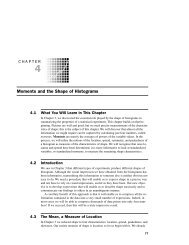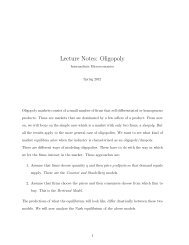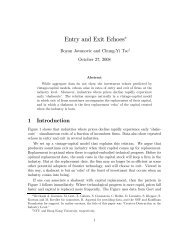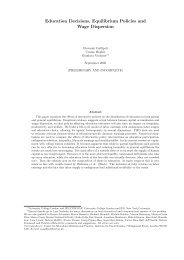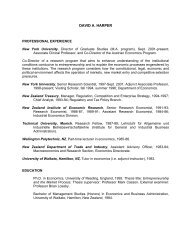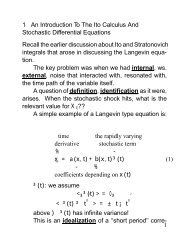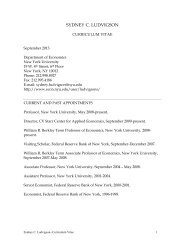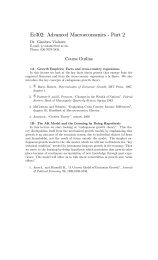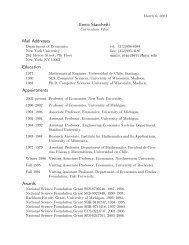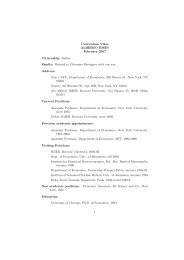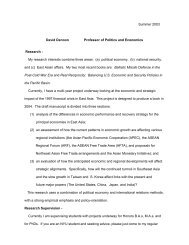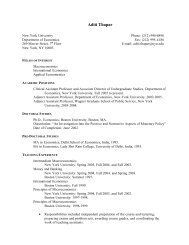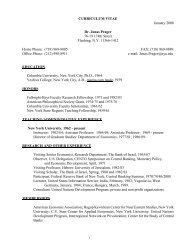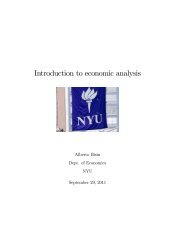On Spatial Processes and Asymptotic Inference under Near$Epoch ...
On Spatial Processes and Asymptotic Inference under Near$Epoch ...
On Spatial Processes and Asymptotic Inference under Near$Epoch ...
Create successful ePaper yourself
Turn your PDF publications into a flip-book with our unique Google optimized e-Paper software.
The …rst part of Assumption 7(a) is needed to ensure that the estimator<br />
b n lies in the interior of with probability tending to one, <strong>and</strong> facilitates the<br />
application of the mean value theorem to Rn( b n) around o n. The second part<br />
states in essence that the moment conditions are correctly speci…ed. Its violation<br />
will generally invalidate the limiting distribution result.<br />
Assumptions 7(c),(d),(g) enable us to apply the CLT for vector-valued NED<br />
processes given above as Corollary 1 to Rn( o n). Some low level su¢ cient conditions<br />
for Assumption 7(c) are given below. To establish asymptotic normality,<br />
we also need uniform convergence of r Rn on , which is implied via Assumptions<br />
7(c),(d),(e),(f).<br />
Given the above assumptions, we have the following asymptotic normality<br />
result for the spatial GMM estimator de…ned by(23).<br />
Theorem 4 Suppose fDng is a sequence of …nite sets of D such that jDnj ! 1<br />
as n ! 1; where D R d ; d 1 is as in Assumption 1. Suppose further that<br />
Assumptions 5- 7 hold. Then<br />
where<br />
A 1<br />
n BnB 0 nA 10<br />
n<br />
1=2 jDnj 1=2 b n<br />
o<br />
n =) N(0; Ik);<br />
An = [Er Rn( o n)] 0 P [Er Rn( o n)] <strong>and</strong> Bn = [Er Rn( o n)] 0 P<br />
h<br />
jDnj 1 i1=2 n :<br />
Moreover, jAnj = O(1); A 1<br />
n = O(1); jBnj = O(1); (BnB 0 n) 1 = O(1) <strong>and</strong><br />
hence, b n is jDnj 1=2 -consistent for<br />
o<br />
n.<br />
As remarked above, relative to the existing literature Theorem 4 allows for<br />
nonstationary processes <strong>and</strong> only assumes that qi;n <strong>and</strong> r qi;n are NED on<br />
an -mixing input process, rather than postulating that qi;n <strong>and</strong> r qi;n are -<br />
mixing. The latter assumption is restrictive in that the -mixing property is not<br />
preserved <strong>under</strong> transformation. Since the NED property is preserved <strong>under</strong> a<br />
wide range of transformations it accommodates a much larger class of dependent<br />
spatial processes, including in…nite moving average <strong>and</strong> spatial autoregressive<br />
models. As such, Theorem 4 should provide a basis for constructing con…dence<br />
intervals <strong>and</strong> hypothesis testing in a wider range of spatial models.<br />
Using Proposition 2, we now give some su¢ cient conditions for Assumption<br />
7(c).<br />
Assumption 8 The process fZi;n; i 2 Dn Tn; n 1g is uniformly L2-NED<br />
on f"i;n; i 2 Tn; n 1g of size 2d(r 1)=(r 2) for some r > 2:<br />
Assumption 9 For every sequence f ng on , the functions qi;n(Zi;n; n) <strong>and</strong><br />
r qi;n(Zi;n; n) satisfy Lipschitz condition (2) in z, that is, for gi;n = qi;n or<br />
r qi;n:<br />
jgi;n(z; n) gi;n(z ; n)j Bi;n(z; z ) jz z j :<br />
18



